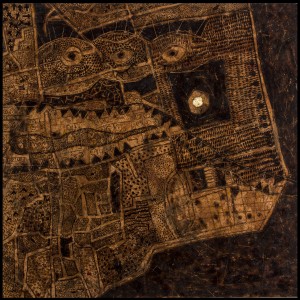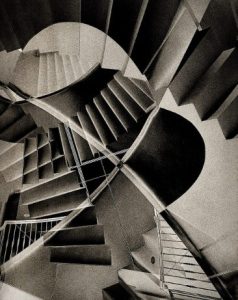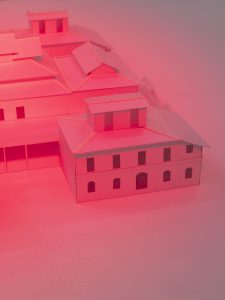
עבודותיו של שר עשויות לוחות וקליפות שעם, חומר המטעין אותן במשמעויות נרמזות. השעם הוא קליפתו החיצונית של עץ אלון השעם, המקולפת מהגזע אחת לתשע שנים. העצים סובלים אפוא מטראומה חוזרת ונשנית, ונמצאים בתהליך מתמיד של שיקום וצמיחה. יכולת ההתחדשות של העצים, העמידות של השעם בשריפות (בבחינת הסנה שאיננו אֻכּל), הפכו אותו לחומר המועדף על ידי שר כבסיס ליצירה.
התערוכה ממוקמת במוזיאון מגדל דוד – נקודת ממשק בין העיר העתיקה לחדשה. המוזיאון מוקדש לתולדות העיר ושוכן במבנה היסטורי שיסודותיו בתקופה ההרודיאנית, ומאז עבר גלגולים אדריכליים בתקופה המוסלמית, הצלבנית, הממלוכית והטורקית.

Jerusalem 950 sqm no 2 153×153
ברחבי המוזיאון מפוזרים מעין פתקים (טריזים) קטנים, פיסות שעם צבועות אדום שעל כל אחת מהן נכתבה משאלה בשפה אחרת. שר מתייחס דרכן לאמונות השונות ולגילויי הדבקות הדתית העממית שהתפתחו סביב ירושלים, ובמיוחד המנהג היהודי של הטמנת פתקים בכותל. בעבודה תלוית המקום, כמו בעבודותיו האחרות, שר אינו משחזר או מעתיק אובייקט אלא יוצר שפה סימבולית: צבע דם-ארגמן (המסמן את בגדי הכוהנים ועד דם הקורבנות) וצורה שמזכירה דף נייר מקופל או פתק שנתחב לאבני הכותל.
שר בונה בתוך האדריכלות רוויית הזיכרונות מבנה חדש המסמן פרק נוסף, קצר וחולף, בהיסטוריית המצודה. על המרפסות המדורגות המשקיפות על העיר הוקם מבנה בעל קווים ישרים, המתכתבים עם האדריכלות המודרנית של העיר. צבעו האדום-ארגמן של המבנה, מאזכר את הוד המלכויות השונות שעברו בעיר; את דם מגִניה ולוחמיה; ואת תמרורי האזהרה האדומים. למתבוננים מקרוב יתגלה תוואי של מפה אוּטוֹפית המודפסת עליו: שר חיבר את מפות העיר העתיקה והעיר החדשה, כך שרחובות העיר החדשה שונו והוצרו כסמטאות העיר העתיקה. כך נוצר דימוי הקרוב למציאות אך פנטסטי, סינתזה בין חדש וישן, שממחישה עד כמה שבירה אשליית הקִדמה.
מפות ירושלים וסַפּוֹלְיָה הן שתי סדרות המוצגות במבנה האדום, ומתייחסות לאדריכלות הממשית והמדומיינת של העיר, לסבך הכמיהות והזעם שנמסכו בה. שר תר אחר מפות העיר מתקופות ומקומות שונים, חלקן מוכרות כמו ‘מפת מידבא’ מהמאה השישית והשביעית; וחלקן אזוטריות. הוא משוטט בין תפיסות ירושלים השונות ומצליב תחושות, אקסיומות דתיות, מידע היסטורי ואסוציאציות אישיות, לכדי תיאור היברידי של חי ודומם, הנע בין תקופות שונות מהעבר, אוטופיות ודיסטופיות.
בחצר פנימית המובילה מהמרפסות למגדל המרכזי, נגלית לעיני הצופים עבודת רצפה גדולה עשויה גושי שעם, המצטרפים יחד למפה מרוסקת שחלקיה התערבבו אלה באלה, כאילו יד נעלמה קרעה אותם ופיזרה לרוח את הקרעים. זו מפה שהמתבונן יזהה בה רמזים למבנים ולאזורים מוכרים, אך הם אינם מתחברים יחד לכדי תמונה קונקרטית.

אלפי שנים נלחמים ונאבקים עמים, ממלכות ודתות, על השליטה בשטח הקטן של ירושלים העתיקה. מיליוני בני אדם איבדו לאורך ההיסטוריה את חייהם כשרוממות קדושת העיר בגרונם. העבודות של שר, על שפע הסמלים והסימנים, החריטות, הצריבות, סימני הקרע והכאוס שלהן, הן רלוונטיות גם למוקדי סכסוכים מתמשכים אחרים ברחבי העולם. הן מתבוננות בפונדמנטליזם ובצדקנות המובילים למלחמה אינסופית בירושלים, כמו בכל מקום שבו להט אמוני נפגש באפלת האלימות.
***
על הסדרות במבנה המרכזי :
מפות עכשוויות, כמו גם מפות קדומות, משרטטות את הגאוגרפיה הרוחנית והעירונית של העיר, ומשקפות את מצב האמונה וההתמסרות לדת, במעין דיאלוג מתמיד של פירוק ובנייה, השחתה וריפוי, שימוש משני (סַפּוֹלְיָה) בחלקים ממבנים שחרבו – כל אלו הם ממאפייניה המובהקים של העיר.
מפות ירושלים – עבודות המבוססות על מפות עתיקות ומפות בנות-זמננו של העיר העתיקה, שבהן מודגשים לחלופין אופני התפיסה של השטח – הקטן מקילומטר מרובע – בעיני הדתות השונות. הר הבית מסומן בעלה זהב; גודלם ומיקומם של אתרים אחרים, כמו כנסיית הקבר, מסומנים בהתאם למשאלות הלב, שבירושלים הן חזקות לא פחות מהשטח הגיאוגרפי.
ספוליה – סדרה המתייחסת לשימוש המשני (בלטינית: sapolia) בחלקי מבנים שנהרסו לצורך בניית מבנים חדשים. שימוש זה יוצר שרשרת ‘לידה מחדש’ בתוך המבנים החדשים, של נצירת זיכרון העבר בתוך ההווה, וגם של הבטחה מרומזת לעתיד הצפוי.
אוצרת: ד”ר סמדר שפי
(טקסט התערוכה )
ניוזלטר הפירסומי השבועי של “החלון” בנושאי אמנות, אירועים ותערוכות חדשות
www.smadarsheffi.com/?p=925 (הרישום נפרד מהרישום לבלוג )
לפרטים על סיורי אמנות והצטרפות לקבוצה הקבועה כיתבו ל
thewindowartsite@gmail.com
The tension between the eternal and the transient is one of the intrinsic qualities of metaphysical and concrete Jerusalem. In the exhibition 950 sq.m.: Alternative Topographies Avner Sher explores, examines, and observes the complexities arising from this tension.
Sher’s point of reference is the Old City of Jerusalem, bowed by conflicting ideologies and beliefs. Sites holy to the three major monotheistic religions are concentrated within a geographical area of less than one square kilometer.

Sher’s works are made of sheets of cork, material charged with multilayered meanings. The cork is the external bark of the cork tree, peeled off once every nine years, thus creating repetitive trauma for the trees. The trees’ capacity for rejuvenation, the cork’s resilience to fire (like the burning bush which was not consumed) has made cork Sher’s preferred material.
The exhibition is located in the Tower of David Museum of the History of Jerusalem, an interface between the ancient and the new city. The Museum, installed in an historical building with foundations from Herod’s time, has undergone architectural transformations through the Muslim, Crusader, Mameluke and Turkish eras.
Throughout the Museum, Sher distributed small wedges of cork which look like little notes. Painted red, each one bears a wish in a different language. They allude to the diverse faiths and fervent beliefs of folk religion that developed regarding Jerusalem, especially the Jewish custom of placing small notes with prayers among the stones of the Western Wall. In this site-specific work, as in Sher’s other works, he creates a symbolic language: the crimson red color creates a chain of associations, from the Temple priests’ clothing to the sacrificial blood, which, combined with the forms bringing to mind the notes folded and slipped into the Wall.
On the graduated balconies overlooking the city, Sher has built a new structure, adding a, transient chapter to the architecture immersed in history. Its clean geometry corresponds with the modernist architecture of the western section of Jerusalem. The crimson red evokes blood and glory, warning signs, and more. Upon a closer look, viewers will discover the outlines of a utopian map printed on the building: Sher merged maps of the Old City and the new, by changing the city streets on the western side and narrowing them like the Old City alleys to form an image close to reality, but which is nevertheless fantastic. The synthesis of new and old shows just how fragile is the illusion of progress.

Maps of Jerusalem and Spolia are two series on exhibit in the red pavilion, referring to the concrete and imagined architecture of the city, to the maze of longings and rage woven within its very fabric. Sher follows the history of the city maps from different eras and places, some familiar, as the Madaba Map from the 6th/7th century C.E., while others are esoteric. The artist wanders through various perceptions of Jerusalem, cross-matching sensations, religious axioms, historical data and personal associations to weave together a hybrid depiction of living things and inanimate objects moving between various periods, utopias and dystopias.
In the inner courtyard, leading from the balcony to the central tower, viewers can see a large floor piece made of pieces of cork which together form a shattered map whose components have been torn by an invisible hand which scattered in all directions. This is a map containing hints of familiar sites and areas that do not merge into a coherent picture.
For millennia, peoples, kingdoms and religions have been engaged in combat for control of this small area of ancient Jerusalem. Millions have lost their lives throughout history, placing the sanctity of the city above their own fate. Sher’s works of art, with their rich repertoire of symbols and signs, incisions, scorched areas, rents and chaos, are also relevant to conflict zones throughout the world. The works critically observe the fundamentalism and self-righteousness leading to the unending war for Jerusalem, as in every location in which faith’s flame burns, encountering dark violence.
***
Two series of works are exhibited inside the temporary pavilion:
Contemporary maps, like ancient ones, delineate the spiritual and urban geography of the city, reflecting a continuous dialogue of deconstruction and construction, destruction and rebuilding, secondary use and repurposing of ruins – these are some of Jerusalem’s outstanding characteristics.
Maps of Jerusalem is a series based on ancient and contemporary maps of the Old City, each with a different emphasis on the perception of the area of less than a square kilometer as seen by various religions. The Temple Mount is prominent, decorated with gold leaf, but not necessarily in its location; the size and placement of other sites, such as the Holy Sepulcher, are marked according as the mapmakers wish to do so, reflecting desires which are stronger than geographical fact.
Spolia is a series whose title is a Latin word referring to the secondary use of elements from destroyed buildings in new structures. This repurposing creates a chain of “rebirth” in the new buildings, conserving the memory of the past within the present, embodying future promise.
(Exhibition text)
Curator: Dr. Smadar Sheffi
Join the mailing list for Window’s weekly informational advertising newsletter –
www.smadarsheffi.com/?p=925
For information about Art tours – please write to thewindowartsite@gmail.com






